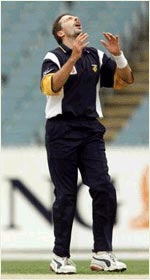Driving length needed from Aussie pacemen
Daniel Laidlaw
Now that Australia has some cricket under its belt on the much-anticipated
tour of India, we can begin to draw some early conclusions with an eye to the tourists' prospects in the main event.
Having battered West Indies into submission with pace and succeeded against
India with the same method last season, the early talk was of overwhelming
the hosts with fast bowling. The Australians were undoubtedly expecting to
do this in the tour opener against India 'A' as they prepared to take on the
full Indian batting line-up. But after Test players Sadagoppan Ramesh and
VVS Laxman handled the second line of attack in Fleming and Kasprowicz with
apparent ease, some doubts must surely have surfaced in the Aussie camp.
In theory, the pre-tour strategy of victory through hostile and accurate
fast bowling was sound. In reality, and execution, the indication is that
the result will be somewhat different.
By compiling a partnership of 195 on a flat track in Nagpur, Ramesh and Laxman surely prompted the tourists to undergo a minor re-evaluation of strategy heading into the Test series. Despite the certainty of flat pitches, it is conceivable the Australians were planning to start the series with just one spinner, Shane Warne, to complement a pace attack of McGrath,
Fleming and Gillespie. But in light of Colin Miller's haul of 6/90 and the
relatively fruitless efforts of Fleming and Kasprowicz, team selectors must
now be seriously contemplating the two-fast, two-spin option.
with just one spinner, Shane Warne, to complement a pace attack of McGrath,
Fleming and Gillespie. But in light of Colin Miller's haul of 6/90 and the
relatively fruitless efforts of Fleming and Kasprowicz, team selectors must
now be seriously contemplating the two-fast, two-spin option.
Although a repeat of the batting success of the 1998 series is unrealistic, the Indian batsmen may be a far tougher proposition than Australia suspected. Though they speak in respectful terms of the Indians' capabilities at home, it is possible that the memory of the harsh treatment received three years ago has faded, or been written off due to McGrath's absence and Warne's injury. If that is the case, then it is an extremely
dangerous path to tread, and one that must be averted immediately. Australia
should be mentally geared for some tough days in the field.
If the performance of Fleming is equally unproductive against a
Tendulkar-less Mumbai, then Australia must consider entering the first Test
with only McGrath and Gillespie as the quick men, unless the Wankhede wicket
is prepared against expectations and offers pace and bounce. More
specifically, Colin Miller has to play, which means omitting once paceman to
clear a spot for Warne.
Ideally, consideration would be given to playing Miller, Australia's Test
player of the year, as the sole spinner, but Australia is seemingly obliged to select a physically fit Warne or endure the 'Warne dropped!' headlines
like those seen after the leg-spinner was left out of the fourth Test
against the West Indies two years ago. Never mind that Miller, with his
accurate, fastish off-spin in addition to the element of surprise he brings,
will prove more difficult for the Indians to handle than Warne.
On top of that, the Australian pacemen have to realise that to be effective
in India, they need to adapt to the conditions. They can't bowl the same
length they do on the bouncier pitches of Australia and expect equal success. With the batsmen having more time to play their shots on the slower wickets, they have to adopt an 'Indian length'.
Nayan Mongia made the point in a recent interview on rediff.com that the
Australians bowled too short in the one-off Test back in '96 and thus did
not exploit the conditions. The reports from the first tour match indicate
that the pace trio again bowled too short for the conditions and were carved
through the off-side by Ramesh. The Aussies need to bowl a driving length to
get rewards.
This should be of particular relevance to Glenn McGrath, who produces the
majority of his wickets with immaculate line and length. McGrath has tended
to struggle when he bowls shorter, negating movement off the seam and giving
the batsmen more time to get positioned. As well as having his temperament
tested, McGrath may find he has to pitch further up and risk being driven
down the ground to get edges.
Of less concern, but still in need of addressing, is the approach the
Australians will take to batting. It seems the Aussies succumbed in the
first innings against India 'A' by attempting to bat too aggressively,
knowing that there were plenty of runs to be had. The Indians proved this
and the Aussies learned from it in the second innings, taking time to get a
feel of conditions first before cutting loose. Two innings against Mumbai is
all the time they have left to get it right.
Mail Daniel Laidlaw